Abstract
Cybulska, Janina (State Institute of Hygiene, Warsaw, Poland), and J. Jeljaszewicz. Bacteriostatic activity of serum against staphylococci. J. Bacteriol. 91:953–962. 1966.—Antistaphylococcal activity of normal serum against strains exhibiting various patterns of coagulase, clumping-factor, and staphylokinase production is not connected with the presence of these factors. Purified coagulase does not influence this property of serum. Coagulase-negative strains with clumping-factor activity grow in normal serum as typical pathogenic staphylococci. Serum bacteriostatic activity against staphylococci may be reversed by several nonspecific factors, such as sterile broth, supernatant fluids of coagulase-negative strains, and ammonium sulfate precipitates of culture supernatant fluids of various staphylococci. Immune sera with a high agglutinating titer for staphylococcal cells do not prevent growth of serum-resistant strains; serum-susceptible strains are inhibited as in normal serum control. Activation or blocking of the serum fibrinolytic system does not influence serum bacteriostatic activity. The growth rate of serum-resistant strains is identical in serum and in Todd-Hewitt broth; serum-susceptible strains are inhibited to the inoculum level, but decreases and increases in viable count are noted during a 24-hr observation period. Observations made with sera of 10 animal species clearly demonstrated differences in serum bacteriostatic activity, mouse serum being completely noninhibitory and cat serum only weakly inhibitory. The technique of quantitative determination of serum susceptibility of staphylococci is described, and the importance of serum antistaphylococcal activity in vitro is discussed. Experimental staphylococcal infection produced in rabbits by intravenous injection of different Staphylococcus aureus strains did not result in significant changes in serum antistaphylococcal activity. The technique of experimental infection used caused chronic infection, with a peak on the 14th day; this was proved by means of a newly developed 5′-nucleotidase test. At the same time, sera of infected animals exhibited slight inhibitory properties, which returned to initial values 1 week later. Infection was produced by strains recognized as nonpathogenic and was inhibited in vitro by sera from both normal and infected rabbits. It is concluded that antistaphylococcal activity of serum should be considered as an “in vitro” phenomenon, which seems to have no importance in defense mechanisms of rabbits infected intravenously with staphylococci.
Full text
PDF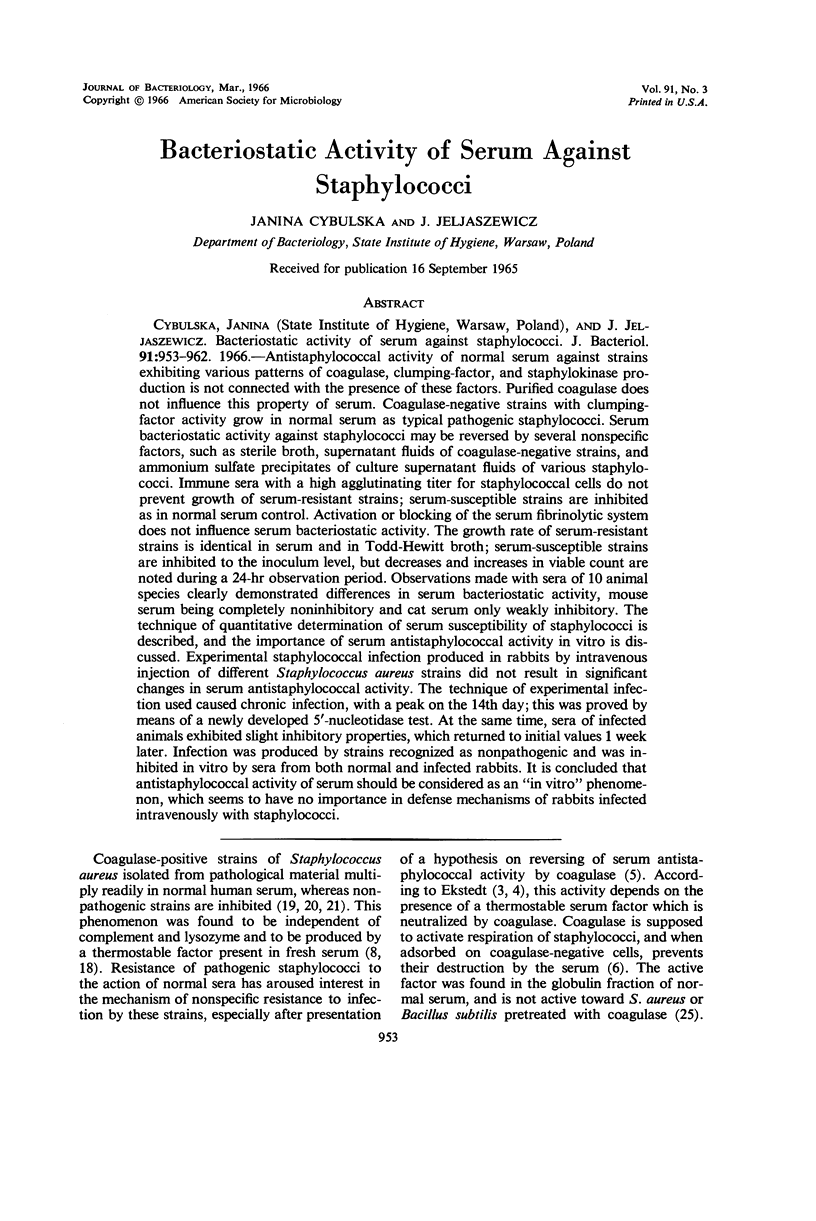

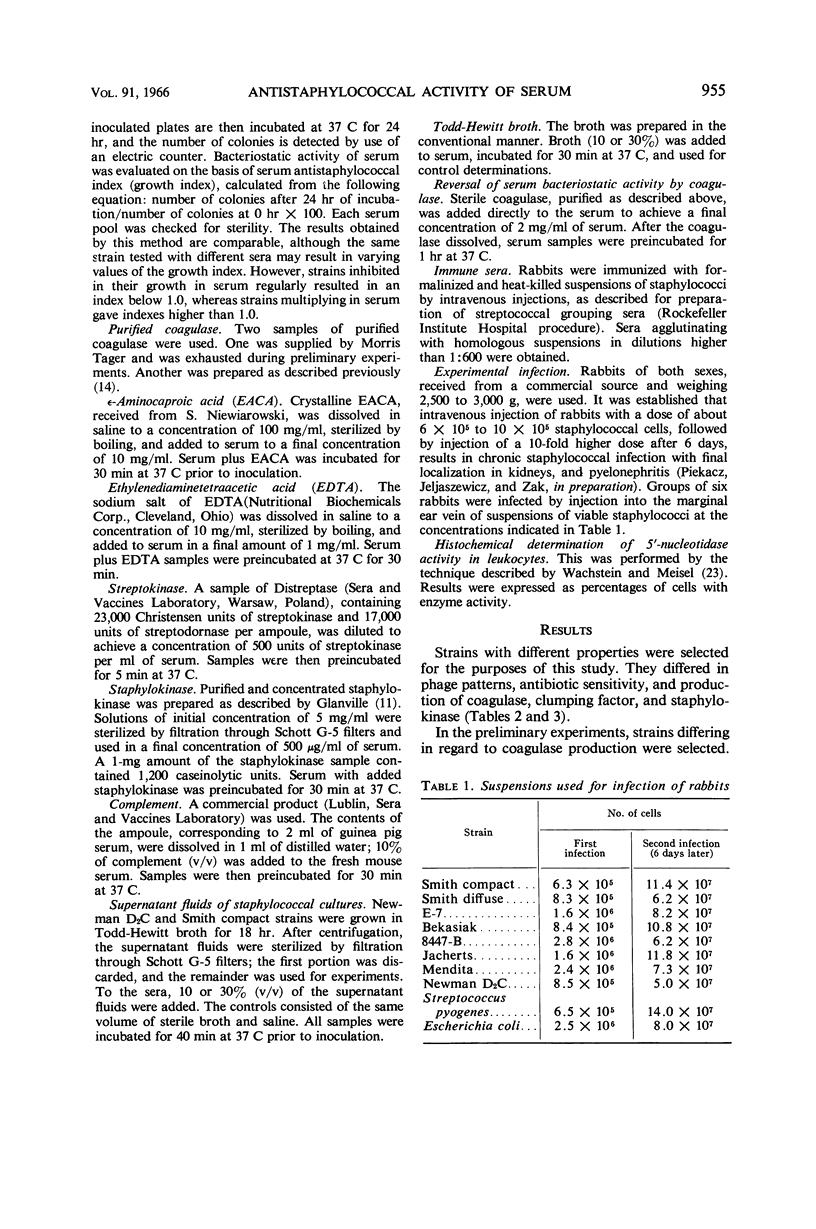

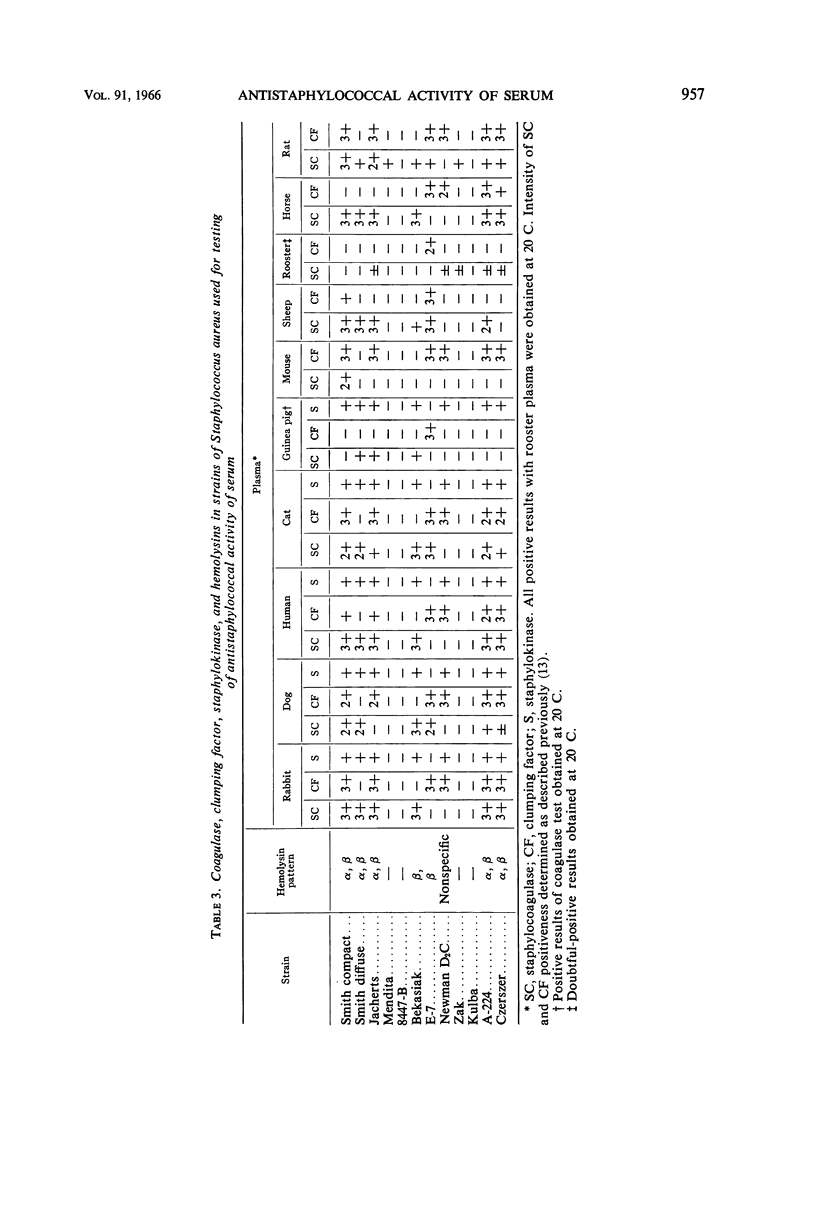

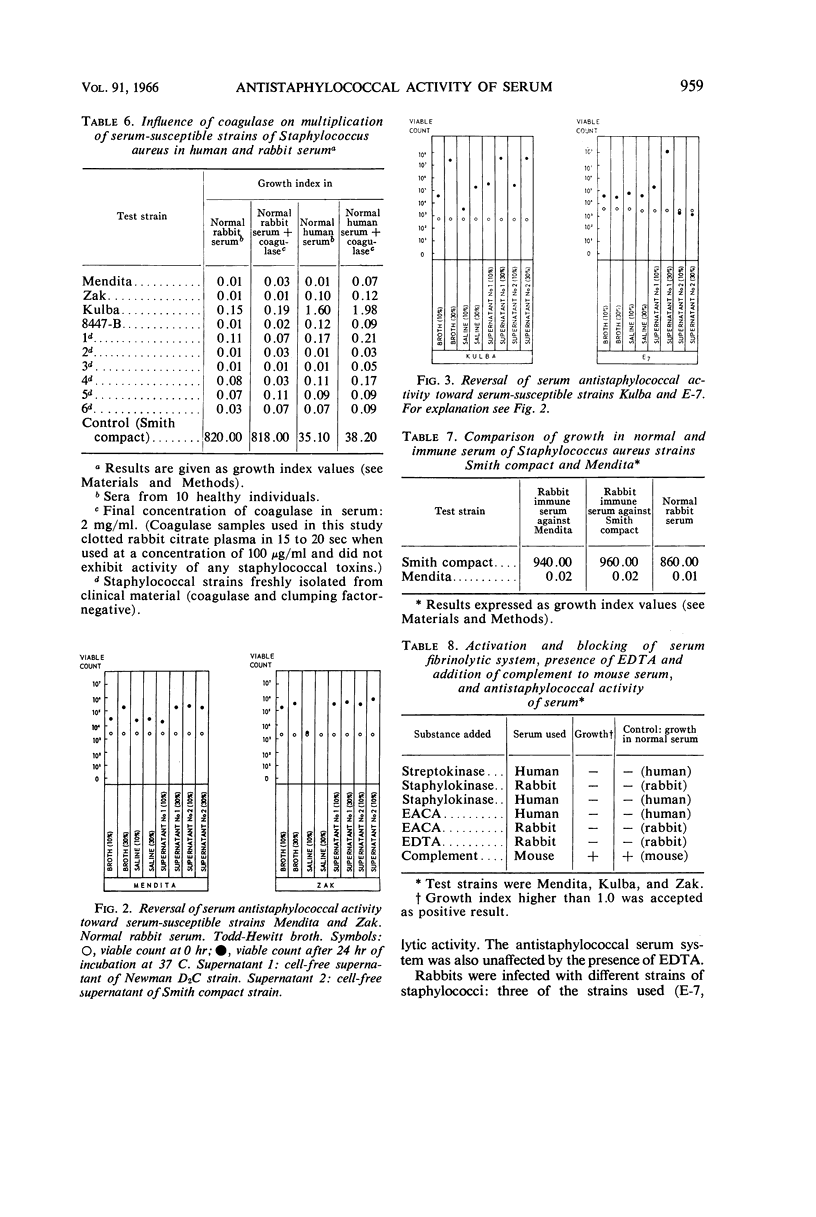


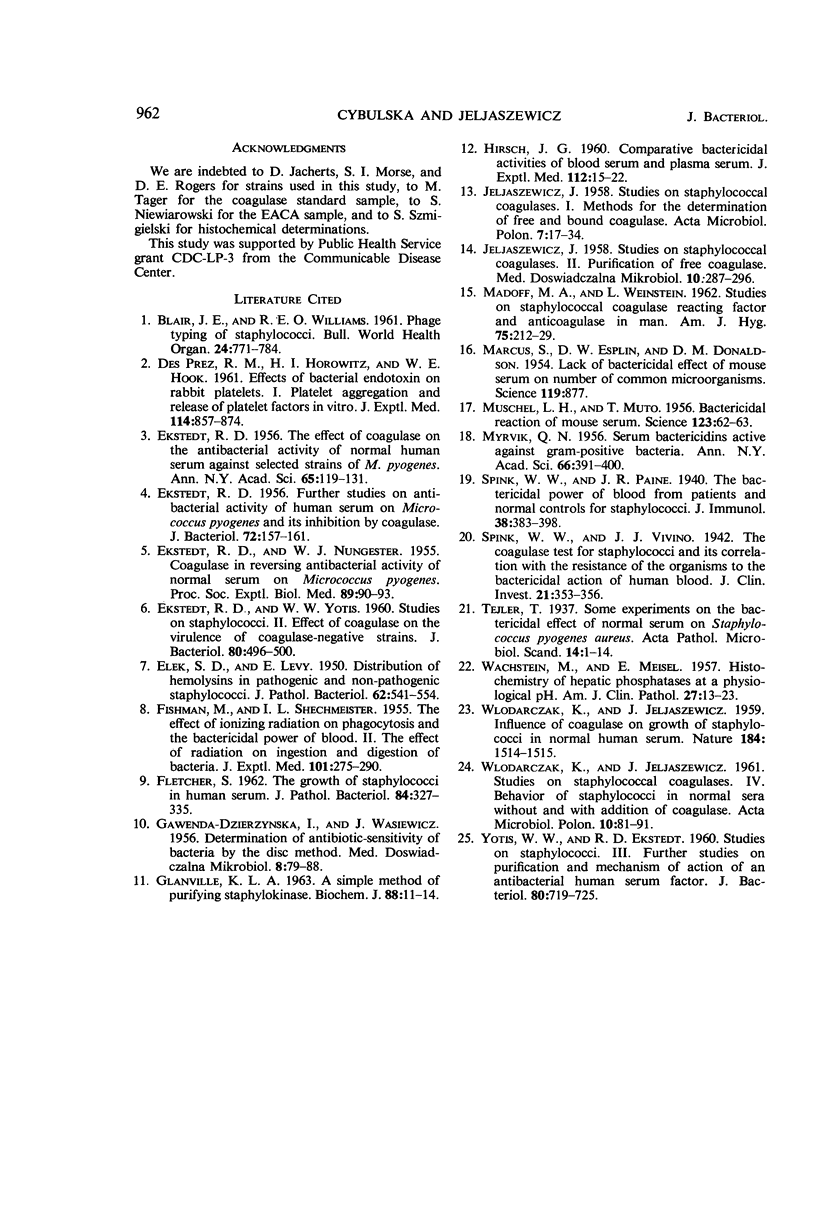
Selected References
These references are in PubMed. This may not be the complete list of references from this article.
- DES PREZ R. M., HOROWITZ H. I., HOOK E. W. Effects of bacterial endotoxin on rabbit platelets. I. Platelet aggregation and release of platelet factors in vitro. J Exp Med. 1961 Dec 1;114:857–874. doi: 10.1084/jem.114.6.857. [DOI] [PMC free article] [PubMed] [Google Scholar]
- EKSTEDT R. D. Further studies on the antibacterial activity of human serum on Micrococcus pyogenes and its inhibition by coagulase. J Bacteriol. 1956 Aug;72(2):157–161. doi: 10.1128/jb.72.2.157-161.1956. [DOI] [PMC free article] [PubMed] [Google Scholar]
- EKSTEDT R. D., NUNGESTER W. J. Coagulase in reversing antibacterial activity of normal human serum on Micrococcus pyogenes. Proc Soc Exp Biol Med. 1955 May;89(1):90–94. doi: 10.3181/00379727-89-21724. [DOI] [PubMed] [Google Scholar]
- EKSTEDT R. D. The effect of coagulase on the antibacterial activity of normal human serum against selected strains of Micrococcus pyogenes. Ann N Y Acad Sci. 1956 Aug 31;65(3):119–131. doi: 10.1111/j.1749-6632.1956.tb36630.x. [DOI] [PubMed] [Google Scholar]
- EKSTEDT R. D., YOTIS W. W. Studies on staphylococci. II. Effect of coagulase on the virulence of coagulase negative strains. J Bacteriol. 1960 Oct;80:496–500. doi: 10.1128/jb.80.4.496-500.1960. [DOI] [PMC free article] [PubMed] [Google Scholar]
- ELEK S. D., LEVY E. Distribution of haemolysins in pathogenic and non-pathogenic staphylococci. J Pathol Bacteriol. 1950 Oct;62(4):541–554. doi: 10.1002/path.1700620405. [DOI] [PubMed] [Google Scholar]
- FISHMAN M., SCHECHMEISTER I. L. The effect of ionizing radiation on phagocytosis and the bactericidal power of the blood. II. The effect of radiation on ingestion and digestion of bacteria. J Exp Med. 1955 Mar 1;101(3):275–290. doi: 10.1084/jem.101.3.275. [DOI] [PMC free article] [PubMed] [Google Scholar]
- FLETCHER S. The growth of staphylococci in human serum. J Pathol Bacteriol. 1962 Oct;84:327–335. doi: 10.1002/path.1700840207. [DOI] [PubMed] [Google Scholar]
- GAWENDA-DZIERZYNSKA I., WASIEWICZ J. Oznaczanie wrazliwości bakterii na antybiotyki za pomoca metody krazków bibułowych. Med Dosw Mikrobiol. 1956;8(1):79–88. [PubMed] [Google Scholar]
- Glanville K. L. A simple method of purifying staphylokinase. Biochem J. 1963 Jul;88(1):11–14. doi: 10.1042/bj0880011. [DOI] [PMC free article] [PubMed] [Google Scholar]
- HIRSCH J. G. Comparative bactericidal activities of blood serum and plasma serum. J Exp Med. 1960 Jul 1;112:15–22. doi: 10.1084/jem.112.1.15. [DOI] [PMC free article] [PubMed] [Google Scholar]
- MADOFF M. A., WEINSTEIN L. Studies of staphylococcal coagulase-reacting factor, and anticoagulase in man. Am J Hyg. 1962 Mar;75:212–229. doi: 10.1093/oxfordjournals.aje.a120245. [DOI] [PubMed] [Google Scholar]
- MARCUS S., ESPLIN D. W., DONALDSON D. M. Lack of bactericidal effect of mouse serum on a number of common microorganisms. Science. 1954 Jun 18;119(3103):877–877. doi: 10.1126/science.119.3103.877. [DOI] [PubMed] [Google Scholar]
- MUSCHEL L. H., MUTO T. Bactericidal reaction of mouse serum. Science. 1956 Jan 13;123(3185):62–64. doi: 10.1126/science.123.3185.62. [DOI] [PubMed] [Google Scholar]
- Spink W. W., Vivino J. J. THE COAGULASE TEST FOR STAPHYLOCOCCI AND ITS CORRELATION WITH THE RESISTANCE OF THE ORGANISMS TO THE BACTERICIDAL ACTION OF HUMAN BLOOD. J Clin Invest. 1942 May;21(3):353–356. doi: 10.1172/JCI101309. [DOI] [PMC free article] [PubMed] [Google Scholar]
- WACHSTEIN M., MEISEL E. Histochemistry of hepatic phosphatases of a physiologic pH; with special reference to the demonstration of bile canaliculi. Am J Clin Pathol. 1957 Jan;27(1):13–23. doi: 10.1093/ajcp/27.1.13. [DOI] [PubMed] [Google Scholar]
- WLODARCZAK K., JELJASEWICZ J. Influence of coagulase on the growth of staphylococci in normal human serum. Nature. 1959 Nov 7;184(Suppl 19):1514–1515. doi: 10.1038/1841514a0. [DOI] [PubMed] [Google Scholar]
- WLODARCZAK K., JELJASZEWICZ J. [Studies on staphylococcal coagulases. IV. Behavior of staphylococci in normal sera with and without added free coagulase]. Acta Microbiol Pol. 1961;10:81–91. [PubMed] [Google Scholar]
- YOTIS W. W., EKSTEDT R. D. Studies on staphylococci. III. Further studies on purification and mechanism of action of an antibacterial human serum factor. J Bacteriol. 1960 Nov;80:719–725. doi: 10.1128/jb.80.5.719-725.1960. [DOI] [PMC free article] [PubMed] [Google Scholar]


